The second JieCang two leg frame we’ve reviewed, that included a cross support system, is the Uplift v2 Commercial. It has been touted by Uplift as their most stable standing desk. While we shouldn’t normally judge on first impressions, when the Uplift v2 Commercial arrived, it weighed more than any two leg desk we’ve tested to date. Our first impressions were that it had a chance to be stable. Let’s take a closer look to see what else the v2 Commercial brought to the table.
Full Disclaimer: We are an office furniture dealer and sell some of the products we review. To learn more about the products we sell, our review process and why you can trust us, please visit: Why we’re different. Who is BTOD.com and The Breakroom Blog?
Uplift Desk v2 Commercial Review Links
– Specs / Pricing / Features
– Assembly Process
– Stability Testing
– Electronics
– Column, Foot and Frame
– Motor and Gears
– Glide Systems
– Testing The Specs
– What I Like
– What I Don’t Like
OEM Manufacturer
The Uplift v2 is currently manufactured by a popular Chinese company, JieCang Linear Motion. This is the same manufacturer used for the Uplift v1 standing desk. They have been producing linear actuators for hospital beds and accessories since early 2000. In 2011, they saw an opportunity to produce adjustable bases, using their linear actuator technology within metal desk frames. They are one of the leading Chinese manufacturers of electric standing desks.
Uplift Desk History
The Uplift desk brand was introduced in 2013. The original version of the desk was the Uplift 900. It was then changed to the Uplift v1. TheHumanSolution.com has made multiple changes to the product, including a switch from the T-base to the C-base now being used. Their most recent release is the Uplift v2 and Uplift v2 Commercial products.
Product Specs
Height Adjustment Range: 21.6” – 47.7”
Travel Speed: 1.35” Per Second
Noise Level: 55-57 Decibels While in Motion
Weight Capacity: 355 lbs.
Adjustable Width Base: 42.25” – 80” W
Adjustable Foot Glides: 3/8” Adjustment
2025 Pricing
| Desk Size | Pricing |
| 30” x 48” | $739.00 |
| 30” x 60” | $839.00 |
| 30” x 72” | $909.00 |
| 30” x 80” | $999.00 |
Features
- Two-stage legs for 26.1” range
- Telescoping base to adjust from 42.25” to 80” wide
- 48 mounting hole system in under desk cross support
- 6-way accelerometer for collision avoidance
- Width adjustable cross support for added lateral stability
Packaging
The packaging for the Uplift v2 includes all frame components in one box and the feet in another box. This reduces the box weight and makes it a bit easier to handle than previous versions we have tested.
Assembly
The assembly on the Uplift v2 Commercial is similar to the other Jiecang frames we have assembled. The only difference being the addition of the expandable cross support, which adds some time to the assembly process.
The same pain point exists with some of the hardware being difficult to insert and tighten. Using the allen wrench, that’s included,can be time-consuming with the number of bolts required to complete the assembly of the frame. If you have a bit set, I would recommend using a cordless drill to speed the process up significantly.
Stability
The stability of a standing desk is important and not something all new users consider prior to purchasing their desk. Having an unstable desk can create an annoyance that potentially could impact your work. If you are a heavy typist, pc gamer or like to lean on the desk, this could be a problem for you.
WobbleMeter Testing Uplift v2 Commercial
If you would like to see the pictures and videos of us testing the Uplift v2 Commercial on the WobbleMeter, please visit the WobbleMeter Uplift v2 Commercial testing page. Below is the deflection score range guide for the WobbleMeter. How these results impact your experience will depend on your sensitivity to wobble and rocking motions.
WobbleMeter Score Range Guide

0-20 = Excellent Stability
Almost all of the desks tested at sitting height will score between 0-20. This is our baseline for excellent stability since most standing desks provide excellent stability at their lowest heights. Users in this range will not notice motion.
21-30 = Very Good to Good Stability
Between 20-30 most users will not notice the small amount of motion in this range.
31-40 = Good to Fair Stability
Between 31-40 some users may begin to notice the amount of motion in this range. This is especially true the closer the score is to 40.
41-50 = Fair to Bad Stability
Between 41-50 most users will notice the amount of motion in this range. This is especially true the closer the score is to 50.
51-60+ = Very Bad Stability
51-60+ all users will notice the amount of motion in this range. This is especially true for scores that are above 60.
Uplift Desk v2 Commercial WobbleMeter Results
Overall Wobble (Side to Side) Deflection Scores
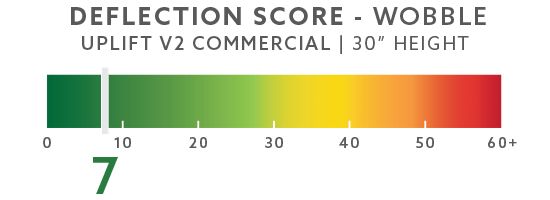

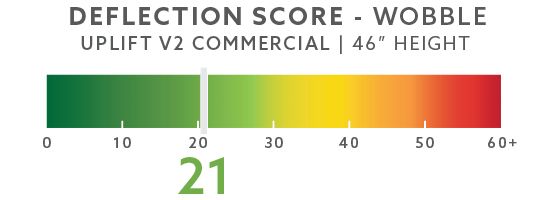
Overall Rocking (Front to Back) Deflection Scores

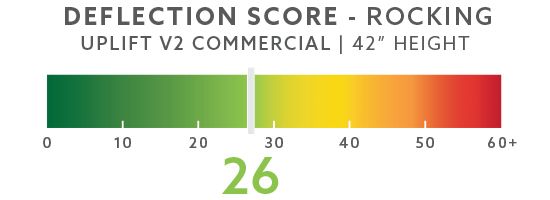

Electronics
The electronics on the Uplift v2 commercial are very similar to that of the standard Uplift v2 Desk. They run one of the most current JieCang control boxes featuring the 6-way accelerometer for collision avoidance.
Taking a closer look at the circuit boards inside the Uplift v2 Commercial, they are very similar to previous iterations by JieCang. Their two board system features a mass produced power supply system. On the power supply, there is a significant amount of silicone caulk used to hold the components in place. Based on our experience, this is common amongst the low to mid range standing desks coming from China. While we’d like to see a cleaner single board system, similar to that on leading brands such as LogicData and Linak, additional costs are likely to prevent this change from occurring.

One of the changes noted on the power supply of the Uplift v2 Commercial is the addition of a grounding wire. With this change, the power cord has changed as well, including a better quality cable with grounding wire.
Column, Foot and Frame Build Quality
One of the first things we noticed when building the Uplift Commercial desk was how heavy the legs and frame were. When compared to other JieCang products, the vertical columns were substantially larger than those found on alternative JieCang frames being sold. The v2 Commercial uses a traditional column design, with the largest column at the bottom and the smallest at the top.
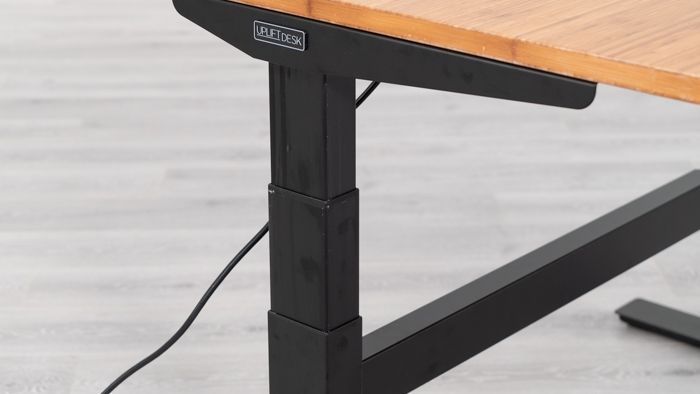
Looking at other JieCang products, including the Uplift v2 Standard, the Commercial’s largest column was .4375” deeper and .375” wider overall. When putting the two largest columns from the v2 standard and v2 commercial, the difference was significant. The column quality was similar to other JieCang products we’ve reviewed, with no real visible seam on the tubes with the black paint finish.
The Uplift v2 Commercial comes with a low profile steel foot design, likely to ensure the frame is able to get to the lower height setting. Like the rest of the frame, the feet were heavy. With 5.25 mm thick plate steel used to build the foot, they were solid. Properly formed to create additional stability and prevent flexing that can occur when the standing desk is at mid to tall heights.
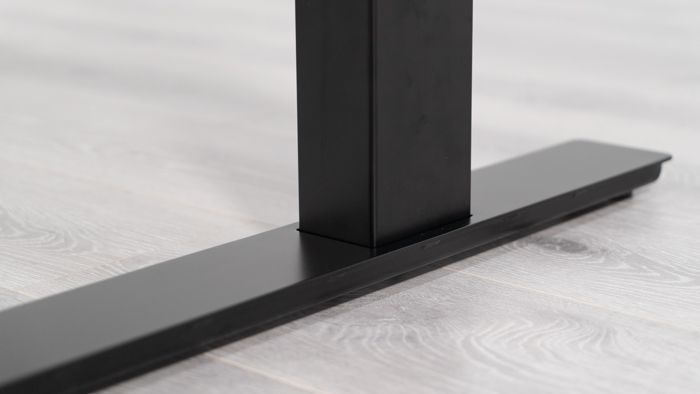
The expandable upper cross support system was also heavier than most JieCang products, which was linked to the recent change Uplift made to include mounting holes for their accessory line. To accomplish this, they welded additional steel to both sides of the original upper frame design, which included 48 mounting holes.
The most noticeable difference to the frame, compared to most other JieCang products available, is the addition of the traditional cross support system. Like the rest of the frame, this was an absolute tank, built with thick steel. Using two set screws, you’re able to lock the width of the cross support to match the upper frame and work surface width.

Motor and Gears
The motors and gears found inside the Uplift v2 Commercial are the latest version of what we have found coming from JieCang. It features a fully enclosed worm drive gear for its motor and improved linear gear system, with proper support tubes for the bottom two thirds of the gear. This is on par with what has been shipping from Jarvis by Fully for well over a year.
There is no doubt that JieCang has been improving upon their earlier versions of columns, with exposed worm drives and not so perfect linear gear systems. As they evolve, they continue to follow the leaders of the pack, Linak and Ketterer. The only issue is that when you follow and don’t lead, you can only get so far.
With so many other glaring weaknesses on previous versions, we haven’t had to go too far in to detail on specific issues within the gears and motors. As JieCang moves closer to mimicking the higher end factories products, we have some specific problems that need to be addressed.
When you look at the latest version of the JieCang gear, one thing that sticks out is the use of a spring just below the motor bracket, attached to the spindle gear. This is something that if you look at our previous reviews of all JieCang, Aoke and other lower cost standing desks brands, each of their gear systems include the same type of spring. The reason this is added to the gear is for prevention of backdriving of the table/desk.

Back driving is the natural result of gravity on the desktop. Once the desk stops moving upward, there is potential for it to drop back down. This is something we are familiar with, as we’ve talked about it in our evolution of a VertDesk post. When originally using TiMotion, we had the same problem, ultimately our OEM needed to educate them on creating a similar spring system on their motor. Something they still use to this day on their large single motor system.
One of the biggest issues I have with the design of this spring is that it restricts movement in both directions. This puts more wear and tear on the motors, likely shortening their life cycle. The other problem is something that premium brands Linak and Ketterer discovered well over a decade ago, these systems require perfect tolerance and grease. Without this, they are almost always too loose or too tight, creating additional friction and potential squeaking issues, or not doing anything at all. Perfect tolerances and grease is not something I have found to be common with JieCang frames we’ve tested.
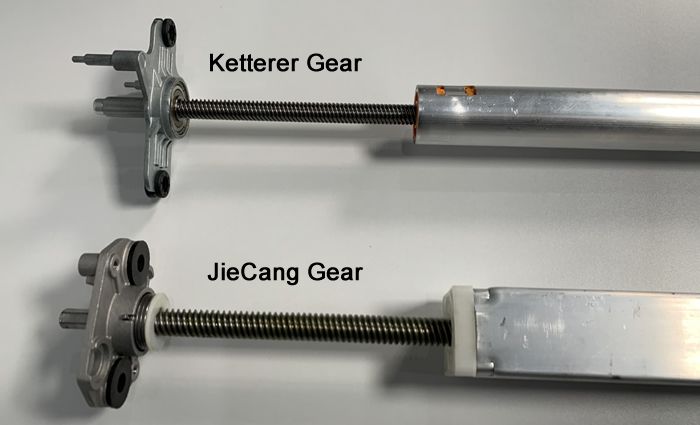
Brands like Linak and Ketterer have found the best solution to back-driving, with the combination of proper engineering within their worm drive gear and electromagnetism from the coil and magnets inside the motor. By using the correct pitch in the worm and worm gear, they are able to naturally hold the table in place when the power is removed from the desk. These systems operate with minimal friction and allow the motors to work as efficiently as possible.
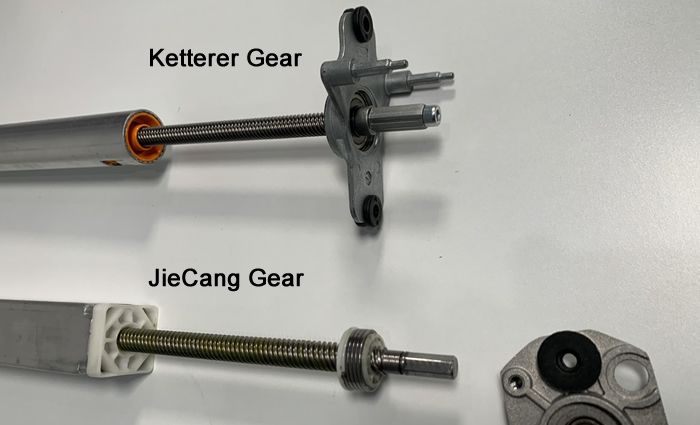
Glide Systems
With the change to JieCang’s column design, there has been a tweak to their internal glide system. This change to the column has created a cleaner look, hiding the previous holes found in the upper portion of the columns. Unfortunately, this has created a weaker upper glide fit, with one size collar type glide for each of the columns.
The rest of the glides found inside the Uplift v2 Commercial are similar to the Uplift v2 Standard frame and other JieCang frames we’ve tested. I have never been overly impressed with the quality of the glides found inside these frames or their design. While the material types of the JieCang glides are unknown, we’ve found similar issues with the glides on other JieCang products tested. Their thin design, with post system that holds the glide and gear system in place are not durable enough in my opinion.
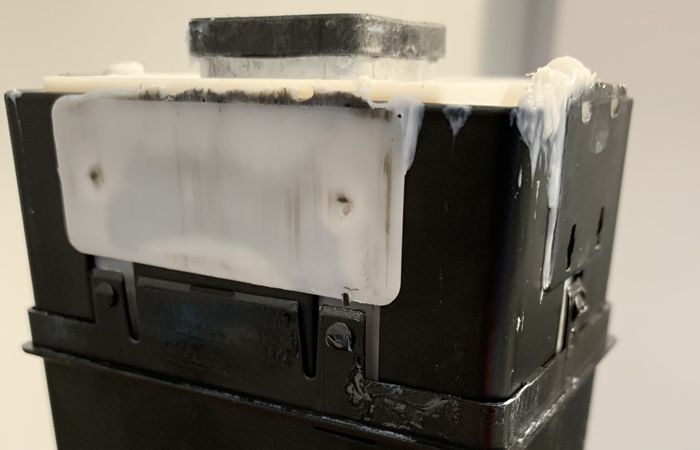
I’ve also found the insides of the columns to be dirty, which has shown to accelerate the wearing on the glides early on. With only a few hundred cycles of the desk, we found grooves forming on the glide systems. As these glides wear down, stability will be impacted as more play is created inside the columns.
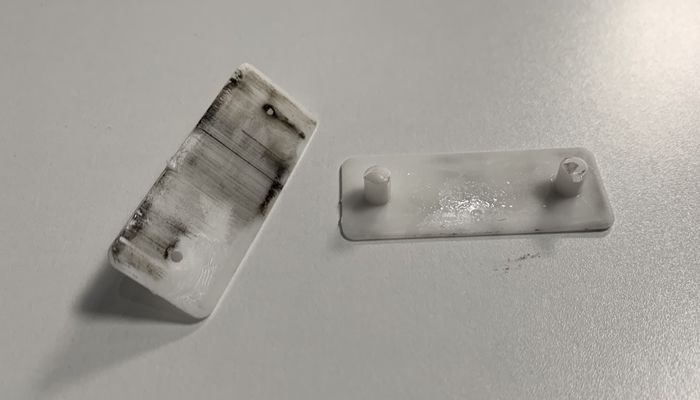

Warranty
Like other Uplift Desk branded desks, the v2 Commercial comes with a solid warranty on the frame. Covering all components of the frame, including electronics, for a period of 15 years.
Testing The Specs
Listed Height Adjustment Range: 22.6” – 48.7” (with top)
True.
Travel Speed: 1.57” Per Second
False. With only the weight of the desk surface, I was able to average 1.35” per second.
Noise Level: 50 decibels
False. We consistently hit 55-57 decibels. While it is noticeable in a quiet room, it isn’t an annoyance and won’t be an issue for most people.
Weight Capacity: 355 lbs.
True. The desk had no problems lifting 355 lbs., with the speed remaining fairly consistent through max capacity. I ended up putting 400 pounds onto the desk to test for overload protection and it stopped moving, presenting an error.
What I like
Traditional Cross Support System
Adding the traditional cross support system to this overbuilt frame created one of the most stable standing desks we’ve tested. According to our WobbleMeter, it was almost identical to our own VertDesk v3 with lateral wobble testing. The only weakness was when we tested it at 46”, which is almost fully extended. This front to back movement is linked to overlap because Uplift decided to maximize their range of adjustment. Overall, it is a very stable standing desk.
Adjustment Range
Starting at 22” and moving all the way up to 48”, the Uplift v2 Commercial was designed to fit most users from 5’ up to 6′ 4“ tall. Getting the right fit out of the box is a nice feature and not having to add any accessories can save you some additional money. If you plan to use the desk below 24” tall, you’ll want to make sure you office chair will go low enough to sit comfortably. When making a switch to this type of setup, you may need to purchase a new chair or consider a footrest and keep the desk a bit taller.
Expandable Frame Design
The expandable frame design is a nice feature to have if you ever decide to change the size of your desk down the road. The only issue we’ve had with it is the stability issues that generally come with a desk using an expandable cross support. The v2 Commercial is a tank and we didn’t find any lateral stability issues arising from the 60” wide setup we tested.
15 Year Warranty On Electronics
It’s well documented that I’m not overly impressed with JieCang’s electronics. The fact that Uplift offers a standard 15 year warranty on their electronics gives you the peace of mind that you should have a functioning desk for at least that long.
Overload Protection System
The addition of an overload protection system to the Uplift v2 commercial was nice to see. This is the first JieCang desk that we have tested to include this feature. Considering the large capacity featured with the Uplift, this is important to ensure you don’t accidentally overload the desk, burn out the motors and void your warranty.
6-Way Accelerometer Collision Avoidance System
With one touch functionality becoming the norm across the industry, better collision avoidance is an absolute must. The desks are powerful and while it’s easy to think you’ll catch the desk before breaking things, or worse yet, hurting someone, I have crushed a garbage can or two in my day. The 6-way accelerometer in the v2 Commercial is a much better system than the standard software driven system on most alternative JieCang products.
What I don’t like
Glide System
Like the electronics in the JieCang frames, I’m not a fan of the glide system used in their frames. Through my testing I’ve found that they tend to wear down quickly, which is concerning when considering stability and functionality of the desk over its lifetime. Additionally, the design of the glide systems in the v2 Commercial eliminated the top glides and replaced it with a plastic cover system. This is unlikely to be as efficient as the standard glide system used for the lower glides, as they will wear down even sooner.
Dated Gear System
JieCang has slowly been making improvements to their products, specially within the gear and motors. While the support tube and cleaner gear system appear to be better, the continued use of a braking coil on their gear is a cause for concern. With both leading manufacturers, Linak and Ketterer, avoiding this system for well over a decade and the fact that it’s still being included on JieCang’s latest technology, tells me they are still following and not leading.
Low Quality Electronics
The two board system found on the Uplift v2 Commercial frame is very similar to that on the standard version of the v2 frame. The addition of the grounding wire is nice, but they continue to use the same low quality power supply with excessive silicone caulk. The two boards are poorly connected with plenty of play between the wires.
While there are worse offenders out there, JieCang is considered to be one of the leaders in China for standing desk frames. This is something that should be addressed. The constant vibrations occur from the desk moving up and down pose a potential threat to this portion of the desk.
White Lubricant Build Up On Black Frame
The two standard Uplift v2 products we’ve brought in and other JieCang frames from companies such as Jarvis have all seen better consistency with their use of excessive white lubricant in the glide systems. I was a bit surprised to see this crop up again, but with a history of it I guess I shouldn’t be.
The enclosure of the motor and gear system should help to protect most of the internal components from dust and dirt being pulled into the desk. If you’re concerned with this I would consider looking at the white or silver frames which do a better job hiding the lubricants.
Final Thoughts
I have to give credit where credit is due, the Uplift v2 Commercial is the first desk we’ve tested out of 25+ that was as stable as the VertDesk v3. Including a traditional cross support on the Commercial desk created equal lateral stability to the VertDesk v3 in our WobbleMeter Results. Only at 46” and above was there “fair” front to back stability issues. This frame is a tank and everything about it is clearly about being stable.
The addition of a more sensitive collision avoidance, overload protection and a 22” starting height are all nice features to have. If you’re interested in the JieCang product, this is the best we’ve tested. All of these features come with a price though, as this is about $200 more expensive than the standard v2 frame from Uplift.
While I really liked the Uplift v2 Commercial frame, there are still areas for improvement. The control box electronics continue to be a sore spot for this line. The dated gear system is also a potential problem later on in ownership. The fact that premium brands such as Linak and Ketterer haven’t consider this system for well over a decade is a big concern to me.


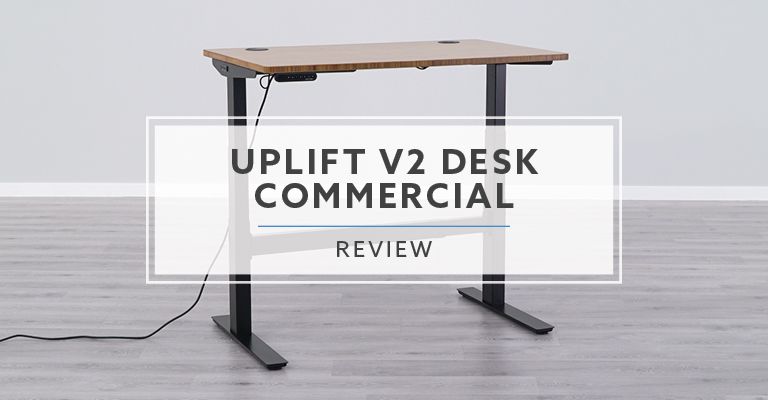




Mike
FWIW, UpliftDesk claims their anti-collision system is the same as their overload protection… I tried to get more info from them, and this was their response:
Kevin P 12:17:56 pm
So after talking with one of my managers, i’m pretty positive that they are referencing the same thing for the two names. The Anti-Collision sensor basically acts as a way to help make sure the desk doesn’t malfunction or break by running into objects as it adjusts up or down that are stationary. If it did run into something or if cords are being tugged on, the desk would stop rising and lower back down a few inches. If the weight is too heavy, the desk wouldn’t move.
Greg Knighton
These are two different systems.